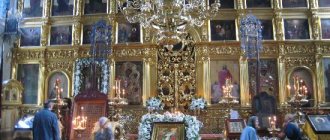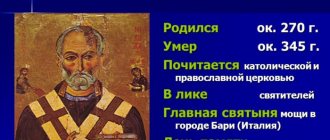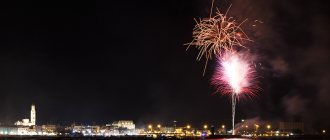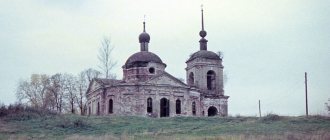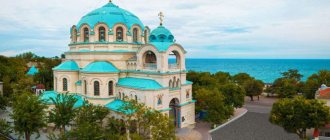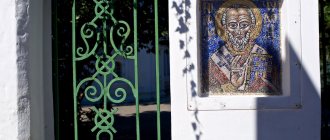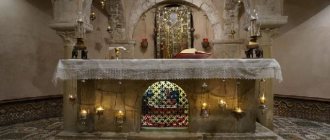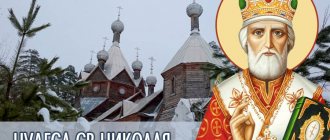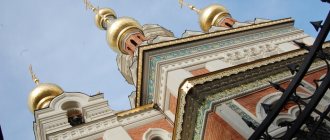History of the temple
In the 17th century, fabric production was concentrated in the vicinity of the Novodevichy Convent in Khamovnichya Sloboda. Craftsmen carried out government orders and received wages from the treasury. The weavers, being, like the entire Russian people, believers, in their work cried out for help to St. Nicholas the Wonderworker. Over time, it was decided to raise funds in honor of St. Nikola Ugodnik. In addition, the saint, although he had no relation to Russia during his earthly life, is a particularly revered saint among the Russian people.
Church of St. Nicholas the Wonderworker in Khamovniki
It is believed that the first version of the wooden temple was erected around 1625. Just 30 years later, in 1657, a decision was made to build a temple of stone - this was a more reliable structure, less susceptible to fire. New stone walls were erected somewhat further from the wooden church. It was this temple that began to be called the Church of St. Nicholas the Wonderworker in Khamovniki.
Initially, the main building of the temple was erected, then the refectory and bell tower were completed. When Napoleon's army entered the city in 1812, Moscow was engulfed in fires. The temple in Khamovniki was not spared the trouble either. It was damaged both inside and outside. Restoration work began after the French retreat. Reconstruction lasted until 1849.
In addition to restoring the walls to their original appearance, the temple was supplemented with decorations and beautiful wall paintings were created. Already in 1896, the first restoration work was carried out and metal fences were installed.
After the revolution of 1917, a government was established in Russia that burned out faith from the consciousness of the people. Orthodox shrines were destroyed, temples and monasteries were destroyed. The global plan for changes within Moscow envisaged the destruction of numerous ancient temples, even despite their historical value. But by the grace of God this terrible plan did not touch the walls of the church of St. Nicholas. Moreover, it was not closed during Soviet times, but in 1949 and 1972. restoration work was carried out there. During the last restoration, the ceramics and color scheme of the facade were restored.
Interiors and shrines
The entrance to the building is under the bell tower. Once inside, visitors see the rich decoration of the temple. The colorful frescoes have been preserved since 1845. They are found on the walls and dome - wherever there are no icons, cornices and stucco moldings.
Inside there is a gilded four-tiered iconostasis, which is crowned with the Crucifixion. The color of the iconostasis harmonizes perfectly with the golden-blue paintings.
The main shrine of the temple is the icon of the Mother of God “Helper of Sinners”. For a long time, the original icon has been located in the Nikolo-Odrinskaya monastery, on Oryol land. The list came to Moscow in 1846 and was kept in the home icon case of Colonel D.N. Boncheskula. Then Dmitry Boncheskul donated this icon to the St. Nicholas Church in Khamovniki.
The church also displays an icon of St. Alexis, painted by the talented royal iconographer Ivan Maximov in 1686. On it you can see an image of the Moscow Kremlin and the Spassky Gate. In addition, the temple is decorated with 17th-century icons of Our Lady of Smolensk and 18th-century icons of the martyr John the Warrior.
Architecture and sights of the monastery
At first glance, the temple looks as if it came out of the illustrations of Russian fairy tales. The monastery is a combination of Moscow Baroque and intricate decorations from Yaroslavl craftsmen. The walls are made of brick and white stone. The white plaster contrasts beautifully with the bright green accents on the corners and arches.
You can get to the main room by passing under the bell tower. The windows of the church are low, so there is no feeling of space from the height of the ceilings. The walls are decorated with rich, very beautiful paintings. It is visible everywhere, with the exception of the cornices and in places under the icons.
The temple was painted in the 19th century according to a single canon.
In addition to painting, the stucco molding deserves special attention. It is distinguished by original patterns. Scenes from the Gospel and the Old Testament and images of seraphim were also made using stucco molding. Above the altar is the central element of the composition - the image of the Holy Trinity. The figures and landscapes used are very realistic and simple. The iconostasis of the temple is four-tiered, decorated with rich gilding.
The church is a complex that includes:
- five-domed temple;
- refectory;
- hipped bell tower;
- octagonal bell tower.
Interior of God's Temple
Bell tower
The tented bell tower of the St. Nicholas Church is one of the largest in the city. She stands on the blind lower quadrangle. Due to its unusual height, the bell tower is noticeably raised above the ground and is visible from everywhere. The second tier consists of graceful arched openings and has eight sides.
The complex vertical is completed by a tent with a small dome. The tent is decorated with three rows of rumor holes and therefore looks very openwork. Each of the 32 holes is framed by a beautiful patterned casing. The architects who built such a miracle clearly did not look for easy ways!
In 1992, a huge bell weighing 108 pounds was raised to the bell tower. Judging by the inscription, it was cast in 1685 by bell-maker Mikhail Ladygin.
In the 1930s, when an active anti-religious campaign began to be carried out in the USSR, the old bell was removed. Fortunately, it was not sent for melting down, but was placed in the storage of the State Historical Museum. The bell remained there for more than 60 years until it took its rightful place in the church bell tower.
Main temple shrines
One of the main shrines of the monastery is the miraculous icon of the Most Holy Theotokos “Helper of Sinners.” It has been in the temple for more than 170 years. The history of the origin of this image is still not completely clear. It is assumed that the icon was created as a prototype of one of the phrases from the akathist read before the icon, “Quench my sorrows.” For a long time, this icon did not stand out in any way from a number of other images of the Most Pure One.
In the 1840s the wife of the merchant Pochepin asked to serve a prayer for health in front of the icon - her son was very ill. The boy suffered from seizures, but no one could help him. Immediately after the end of the service, everyone saw a miracle - the child received healing. This incident quickly became known among the people. They talked about the icon, and the image itself took a place of honor in the temple. Many sick people came to him, asking the Mother of God for healing.
People's rumor made the icon widely known. In the same 1840s. it was bought by a certain Colonel Bonchescu. He was the first to see that the image changes: it shines, and during prayer, reflections come from it and fragrant myrrh appears. People who used the oily drops received healing. To the church of St. Nicholas, the icon came to Khamovniki in 1848, when the colonel donated it there. In the monastery she was placed on a lectern. At night, an extraordinary glow emanated from it, like the twinkling of stars. Many people saw this miracle with their own eyes.
At the same time, the myrrh flow did not stop. One deacon was given the obedience to collect miraculous drops. Myrrh was given to the sick, who came to the temple in large numbers. Evidence of the healing of even cholera and seizures has been preserved. The parish of the temple made efforts to have one of the chapels of the church consecrated in honor of the image of the “Supportress of Sinners” in 1872. Many copies were made of the miraculous icon, and they were distributed to many parts of the country. Without being able to argue with the truth, even non-believers confirm the miracles that occur from the image.
In addition, the temple contains the following shrines:
- image of St. Alexia (XVII century);
- Smolensk Icon of the Blessed Virgin Mary (XVII century);
- martyr icon John the Warrior (XVIII century).
Icon of the Mother of God “Helper of Sinners”
Icon of St. Alexia
Martyr icon. John the Warrior
Why is the settlement called Khamovnichya?
The history of the Moscow region called Khamovnichya Sloboda, or Khamovniki, begins in the 17th century. Today Khamovniki is located in one of the central districts of the capital, but in those distant times it was more of a suburb. In this area, valuable herbs from the point of view of cattle breeding grew over large areas.
Nicholas Church in Khamovniki, 1883
At the beginning of the 17th century, construction began on a convent called Novodevichy. Then this area began to be populated by ordinary people, mainly peasants and artisans. At that time, the needs of the royal court for linen materials grew.
It was decided to create a settlement in the capital, specialized in the production of fabrics. The choice fell on the vicinity of the Novodevichy Convent. Artisan weavers were resettled here from some surrounding villages. In the Old Russian language, flax was denoted by the word “ham”, “hamyan”. Therefore, the settlement acquired the name Khamovnichya.
Craftsmen produced products for the needs of the state, therefore they received salaries from the budget and enjoyed some privileges and benefits. The weavers considered Nicholas the Wonderworker one of their patron saints and turned to him prayerfully, asking for help in work and in everyday life.
What can you pray to Nicholas the Ugodnik for:
- Prayer for good luck and luck
- Prayer for anxiety about the future
- Prayer for family
It was customary to ask St. Nicholas for help in various matters, including work. It was decided to raise funds for the construction of a new temple in honor of this saint.
How does Saint Nicholas help?
Nicholas the Wonderworker is a particularly revered saint in Rus'. There are many known cases of his help through the prayers of believers. Some of them have been preserved in chronicles; many miracles are happening today. People turn to the saint for help in the following needs:
- going on a trip;
- when looking for a job;
- in need (but you cannot ask for abundance, money);
- in illness;
- in difficult life situations;
- in the fight against sins and passions.
Divine services in the temple are held daily.
You should not attribute help to the saint only in certain matters. Asking for help from the saints, we believe and hope in the mercy of the Lord, and the intercession of His saints before Him for us sinners.
Author's advice
Amazing church of St. Nicholas of Mirliki in Khamovniki is a unique monument of history and culture, one of the pearls of Russian Orthodoxy. By the grace of God, this monastery has survived to this day, despite difficult times, wars and revolutions. Now every Orthodox Christian who wishes can visit it by going to Moscow at the address: st. Lev Tolstoy, no. 2.
If you find an error, please select a piece of text and press Ctrl+Enter.
Useful information for pilgrims and tourists
The Moscow Church of St. Nicholas has the status of a cultural monument of federal significance. The doors of the temple are open to believers and tourists from morning to evening. Divine services are held twice a day - at 8:00 and 17:00.
There is a Sunday school at the temple, which teaches children from 6 to 15 years old. Parishioners have created a charitable foundation and help disabled people, socially vulnerable families and elderly residents of the Khamovniki district.
